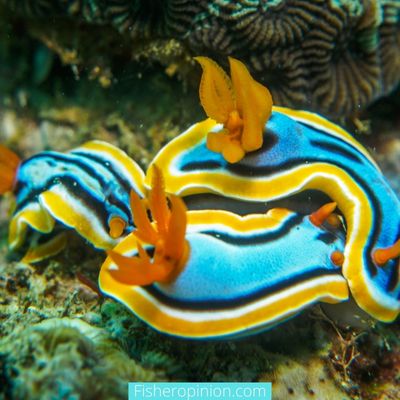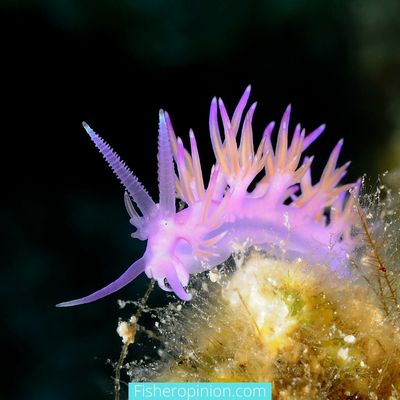What do Nudibranchs Eat?
Usually, nudibranchs are carnivorous predators, and some are picky eaters. They eat-

- Hydroid
- Sponge
- Coral
- Bryozoans
- Anemones
- Eggs
- Tunicates
- Small fish
- Other nudibranchs
Their food habits depend on the spices themselves and the environment where they inhabit. In fact, many nudibranchs have established a close relationship with their prey.
Most of them intake food using a stable and toothed structure similar to a tongue. They use it to take their food from rocks. There are some species of nudibranch that consume only one type of prey.
A surprising fact is that nudibranchs get their vibrant bright color from their food intake. There are some nudibranchs who eat other nudibranchs belonging to their species.
The Spanish nudibranch depends on a species for its food called Eudendrium ramosum. It contains a pigment called astaxanthin, which gives the nudibranchs red, purple, and orange coloration.
However, some other nudibranchs make their food. They eat algae with coral and derive nutrition from ingested photosynthetic algae.
On the other hand, some nudibranchs have a very special diet. They eat just one kind of prey. Besides, there are some other species of nudibranchs named sea hares. They are mainly herbivores and feed on various types of seaweed.
Apart from it, there are also some surprising facts about nudibranchs and feeding, which we will discuss in depth in the article.
What are nudibranchs?
Nudibranchs are a group of tender-bodied, shell-less marine mollusks which belong to the Gastropoda family and are found in the ocean throughout the world.
They are very exoteric and well-known due to their eye-catching color, perplexing pattern, and attractive form. Even they can be identified by the beautiful color and texture of the skin.
They have been given some beautiful names according to their color and shape, such as dragon, marigold, splendid, clown, dancer, sea rabbit, etc.
Moreover, they have a shell in the larval stage but it disappears when they turn into adult age.
What you need to know about nudibranchs- True facts!
| kingdom | Animalia |
| Phylum | mollusks |
| Class | Gastropoda |
| Order | Nudibranchia |
| Common name | Nudibranchs |
| Scientific name | Nudibranchia, suborders Aeolidida and doredacea |
| Niche | Marine gasropoda |
| Basic animal group | Invertebrates |
| Clades | euctenidiacea |
| Species | 3000+ species |
| Life span | A few weeks to a year |
| weight | Up to just over 3 pounds |
| size | 0.25 – 12 inches |
| Social structure | Solidary |
| Conversation status | Not evaluated |
| Preferred habitat | Coral, rocky reefs |
| Number of eggs | 1-25 million (varies widely) |
Characteristics

Nudibranchs are derived from nudus, which means naked, and the Greek word brankhia means gills. Nudibranchs have gill or grill-like appendages that come out from their back.
However, nudibranch species breathe through “naked gill.” Like the “alveoli” of human lungs, the naked gill is shaped into bronchial plums.
Besides, they have a pair of tentacles on their head called rhinophores. They act as sensory organs and help them to taste, smell and get around. Some of them are solar powered and may be toxic to their prey.
Although they contain a feeding organ but characteristically, like mollusks, they don’t have shells, gills, and mental cavities. With the help of their feet, they move but unfortunately, they have a weak vision.
Distribution and Habitat
Nudibranchs have worldwide distributions from the arctic to the antarctic. A large number of nudibranchs can be found on the shallow reef in warm water.
Even recently, a new species has been found at more than 8,200 ft. Most of them love to crawl on the sea floor rather than swim. Finding nudibranchs is often not hard, you may find one in your local pool.
Shape
Usually, they can be long or short, thick or flattened! No fixed shape, actually.
They are so colorful and can easily match their surroundings.
Types
There are two types of nudibranchs.
- Dorid nudibranchs: they have gills on their posterior
- Solid nudibranchs: they contain obvious cerata on their back.
Reproduction
Nudibranchs are hermaphrodites containing both male and female sex organs. They can mate with any other member of their species.
Threats
Nudibranchs have a short life span; they don’t live long. Even survive up to one year, and some are only a few weeks old. The population of nudibranchs is still undefined, though new species are found each year.
However, endangered species internationally suggest that “many species are becoming rare due to degradation, habitat loss, water pollution, and biodiversity decline associated with global warming.”
Are nudibranchs sea slugs?
Yes! In general, nudibranchs are sea slugs!
But there are some other species of sea slug which are not nudibranchs.
- They are stunning.
- They are tiny in size. Some of them are like your thumb, and others size up to 60 cm.
- They breathe with the help of their body parts.
Where do nudibranchs live?
Usually, nudibranchs live all over the world’s oceans. Their habitat starts from the intertidal zone, which has a depth of over 11000 feet. There are 3000+ pieces of nudibranchs; as a matter of fact, they live in different places.
Let’s check it out!
- Some nudibranchs live on a single limestone rock that depths up to 2500mtre.
- Most of the nudibranchs live in shallow water where there is no current.
- Some species are mainly sessile, which means they stay in a single venue.
- Few of them live in the deep water, present in solid currents. In this case, firstly, they have to hold rocks or seaweeds with the help of their feet or other body parts. As a result, they are stuck with that object and can’t go away.
- Even they can even live in cold water to warm water. You can find them in the local pool, thermal vents, or in the hard part of the ocean.

